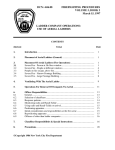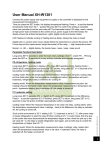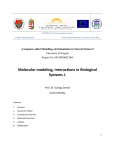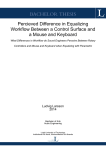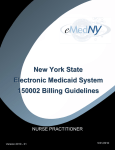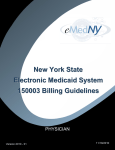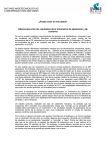Download Your Guide to the On-Site Audit
Transcript
THE INDEPENDENT PHARMACIST’S GUIDE TO THE ON-SITE AUDIT Amanda C. Fields, General Counsel for American Pharmacies (APRx) © American Pharmacies 2011 Introduction As the Texas pharmacists know, audits by insurance companies and third‐party payors are a major threat to both the practice and business of pharmacy. Too often, the on‐site audit is simply a mechanism to get in the door so they can recoup thousands of dollars, frequently from small independent pharmacies. More often than not, on‐site audit notifications request review of records and/or documents that are not within the time or relevance scope of permissibility under Texas law. Unfortunately, many of the pharmacies that receive these notifications comply simply because they don’t understand Texas law, and because they fear the consequences of non‐compliance. Once an insurance company or PBM has conducted an on‐site audit, it typically notifies the pharmacy that it will recoup money by taking out pay‐ments from future money due. Many pharmacies give up a reimbursement just to continue the “privilege” of doing business with their tormentor. It is imperative that you take steps to prevent audits, understand your rights under Texas law, voice opposition to unlawful audits and appeal any demands for recoupment. This guide provides useful tips on handling the on‐site audit. What Can I Do to Avoid an On-site Audit? The best way to not experience the stress and inconvenience of an on‐site audit is to avoid having one in the first place. Here are some simple things that you can do that may help prevent an audit: Carefully review the proposed contract with the auditing entity before you sign it. If possible, have an attorney or consultant review it to determine whether it contains any unreasonable or prohibited auditing procedures. If every Texas pharmacy refuses to sign a contract containing unlawful auditing procedures, then insurance companies and third parties will be unable to continue to do business in Texas unless they comply. It is critical that you maintain sound filing practices. You need to keep on file (and preferably on‐site at the pharmacy) all documents pertaining to your pharmacy’s ongoing relationship with the insurance company or PBM. Those include contracts, fee schedules, manuals, renewals and amendments to contracts, supplemental documents to the contract and all documents that the pharmacy’s representative signs and submits to the insurance company or third party. If there is a third party that negotiates the pharmacy’s contracts, then immediately request all copies of those documents. This is significant so that the terms pertaining to the pharmacy’s legal relationship with the insurance company or PBM can be easily referenced and verified. Once you sign the contract, consistently abide by the terms and conditions in the pharmacy service manual provided by the insurance company or PBM. The pharmacy service manual, typically distributed annually outlines standard procedures and clinical and regulatory information. Study the pharmacy service manual for any audit trouble spots you can avoid. If you do not already have copies of fee schedules for all the prescriptions the pharmacy fills, especially compounded prescriptions, request them immediately. While it makes good business sense that a dispute over the price of a prescription should be resolved at the time of the affirmative adjudication, insurance companies and PBMs often don’t see it that way. They frequently try to audit prescriptions that were submitted via affirmative adjudication and resolved as a clean claim months and even years after the adjudication. Thus, the fee schedule is an immediate way for the pharmacy to know the fees to be paid. Since none of these precautionary measures are a guarantee against the threat of audit recoupments, it is essential to know how to prepare for and handle an on‐site audit. How to Prepare for an On-site Audit First, review the written on‐site audit notification. If you received other than a formal written notice of an entity to provide formal written notification. As you review the audit notification, determine whether the scope of the notification is lawful or can be limited. Texas law may help your position, as it imposes certain limits, such as how far back the audit can retrospectively cover. Does the scope of review comply with the prompt payment to providers and audit standards rules, as codified in Chapters 843 and 1301 of the Texas Insurance Code? If you are not sure, contact an attorney or consultant to assist you in this assessment. You might need legal expertise in opposing an unlawful on‐site audit notification. For example, the auditing entity is generally not permitted to review clean claims submitted more than 180 days prior to the audit date. If the on‐site audit notification is in violation of Texas law, you can ask that it be re‐sent or that it be cancelled altogether. The auditing entity may attempt to claim that you waived these rights via your contract or pharmacy service manual, but the Texas Insurance Code provides that prompt pay and audit standards cannot be waived by contract. You should then determine whether the date and time set for the on‐site audit is convenient and feasible. If it is not, ask for it to be re‐scheduled. Do not allow the on‐site audit to occur on a day that you are unavailable. This is not a task that should ever be delegated to staff. If the audit is rescheduled, ask for written confirmation of the new date, including the scope of records to be reviewed. What will the auditing entity be reviewing, i.e., what hard copies and signature logs or other records must be available for review during the audit? Begin thinking about any potential problems with your records. After you carefully review the written audit notifica‐ tion, create an internal file and/or box related to the audit. Your internal file/box should begin with the written on‐site audit notification and include all subsequent notes, correspondence and documented telephone conferences or other communications. If it pertains to the audit, put it in your file/box. Keep all files in chronological order with the most recent infor‐ mation on top. It is important to stay organized and document your actions at each phase of the audit. A Quick Checklist for Audit Preparation Carefully review the written notification of the audit; Agree to an audit date only for a day when YOU are fully available. If the proposed date is inconvenient, reschedule. Create a file/file box in which to keep all audit‐related corre‐ spondence, records, notes and documentation of all related telephone calls. Contact pharmacy owner colleagues for support & useful information. Meet with your staff to prepare them for the audit. Organize and prepare your records before the audit date. Conduct a self‐audit to identify any possible problems or issues. Prepare a designated physical area for the audit that is private and out of view of your pharmacy’s employees and operations Consider videotaping or recording the audit for your records (and your protection!) Also keep a copy of your contract with the auditing entity, including all supplements and amend‐ ments , as well as your pharmacy service manual . Carefully review these documents, paying special attention to any provisions related to on‐site auditing authority, procedures and policies. Contact the auditing entity. If the scope of the on‐site audit notification is lawful, confirm in writing your availability for the audit and request what policies and procedures from your contract and/or pharmacy service manual govern the audit. Request a statement of why your pharmacy was selected for the on‐site audit. Try to determine whether the auditing entity claims that it is random, related to their review of your dispensing trend analysis or for some other reason. Also request a copy of the prescription numbers that are the subject of the audit. The auditing entity may not respond to your written request, but you should attempt this task, as it is important to laying the early groundwork for your strategic defense of the audit and any potential negative findings. Contact your pharmacist/pharmacy owner colleagues and connections within your pharmacy organizations to determine whether they have recently experienced an on‐site audit by the same auditing entity. Ask them about their written on‐site audit notification, the details of what the on‐ site audit entailed, and the outcome of the on‐site audit findings. You should use these conversations as a means to educate yourself in ways to avoid a negative outcome for your pharmacy. Take notes during these discussions and place them in your internal file and/or box. You should hold a meeting with your staff in order to prepare them for the on‐site audit. You should let them know the date and time of the on‐site audit, and inform them of your expectations that they act with the utmost professionalism during the on‐site audit. In particular, ensure that the staff is instructed not to actively communicate or interact with the auditor, and that if the auditor asks them questions or for information, that they should immediately refer the auditor to you. You do not want your staff directly involved in communicating with and/or assisting the auditor. Organize and prepare your records before the audit. De‐clutter your pharmacy and make sure it appears to be a well‐run, efficient operation. Prepare a separate room (an empty office or break room) for the auditor to use, and limit the audit to this designated area. Ideally, the audit should occur in an empty room with a table, and the auditor should remain in this room with the door closed when you leave to you track down any needed documents. Don’t let the auditor sit next to your drug shelves, records or computers, or observe your pharmacy’s transactions. Conduct your own internal audit well in advance to identify potential problem areas before the real audit. The written on‐site audit notification will define the scope of the audit, i.e., the hard copies and signature log range required for review. You should conduct a random sampling and review of items within this range, and ensure that you have the original prescription for any refills, the delivery records are in order, correct DAW codes and NDC numbers are maintained, and most importantly, proper signature logs are maintained (no missing signatures!). Compounded prescriptions are typically reviewed more aggressively, so check those with a careful eye. If at all possible, print a listing of each prescription that could be included in the on‐site audit and review it. Ensure you billed the usual and customary price if the auditing entity requires such. Consider videotaping the on‐site audit. You are permitted to record the audit with audio and/or video. If you decide to do so, please ensure prior to the audit day that your equipment works properly and that comfortable using it. If you would like, have another responsible staff member record the audit, but do not allow the “recorder” to become actively involved in the audit process. You, as the pharmacist/pharmacy owner, should be the exclusive contact or “go‐to person” for the auditor during the entirety of the on‐site audit. What to Do During the Audit Be on time to meet the auditor. You should be waiting for the auditor to arrive in the room designated for the audit, and should be the first person to greet the auditor. Introduce yourself as the contact for the audit and offer your auditor a beverage and/or snack. If you have decided to videotape the audit, begin filming at this time. State the date and time and purpose of the taping on the video. Should the auditor state that videotaping is against company policy, don’t engage in a debate. Explain that the videotape is so that you can remember the details of the audit for recordkeeping purposes and to help you train your staff in preparation for future audits. If the auditor is still unwilling to agree to the taping, then simply take detailed notes during the audit. Always be professional, polite and courteous to the auditor. Ensure that you maintain a high level of professionalism throughout the on‐site audit. Being angry, sarcastic, rude or uncooperative will only ensure a more difficult and comprehensive audit. That does not mean you cannot question or challenge the auditor, but do so in a polite, respectful manner. Take an active role in the audit. Before the actual audit starts, discuss the scope of the audit and your mutual expectations for how the time will be spent. If you have not already obtained them, ask the auditor for a list of the prescriptions to be audited (typically about 100). Ask why your pharmacy was selected for the audit: is the audit random, due to a review of your dispensing trends or another reason. Determine if the auditing entity uses any extrapolation methods, and, if so, exactly what they are. Make it clear to the auditor that you are the only person to be questioned during the audit. After you establish a “game plan” for the on‐site audit, assure the auditor that you will provide any needed documents or records. Express your desire to be helpful, resolve any discrepan‐ cies and make the process as painless as possible. Checklist: What to Do During the Audit Be on time to meet the auditor. Be professional, polite and courteous at all times. Actively participate: discuss the audit’s scope & mutual goals. Take detailed notes throughout. Ask any questions that arise and carefully record the answers. Protect patient data in accord‐ ance with HIPAA guidelines. Give copies – not originals – of documents & records. Don’t leave the auditor alone with your records or allow the auditor to wander the store. Hold an exit meeting before the auditor leaves to determine all discrepancies/problems identi‐ fied in the audit. If possible, get the list in writing. Take very detailed notes in a notebook or on a legal pad throughout the entire on‐site audit. These notes should include information about every aspect of the on‐site audit and should go in your internal file/box when the audit is complete. Ask questions during the audit and record the answers. State all your questions politely and clearly. Answer all the auditor’s questions honestly, but do not volunteer additional information. Many questions can be answered with a simple “yes,” “no,” “I do not know” or “I do not remember.” Protect patient information pursuant to the Health Insurance Portability and Accountability Act (HIPAA). Be sure that the auditing entity has signed a “business associate agreement” with the third‐party payor as required by HIPAA so that the auditor will keep information confidential. Provide information requested during the audit, but do not disclose any records or documents outside the scope of the written audit notification. The audit remains limited to the parameters of the written audit notification. Always provide the auditor with copies – NOT ORIGINALS ‐‐ of all relevant records and documents so that you can later study what was audited and prepare to appeal or rebut any negative findings. If the auditor later requests the same records at some point, you can prove that you already provided them. Make written notes of what copies were provided to the auditor. Do not leave the auditor alone with your records. Bring all needed documents and/or records to the auditor and do not allow the auditor to wander around or follow you while you track down documents. Do not allow the auditor to walk among your drug shelves, search through records or look at your computer or electronic information. Allow the auditor to view only those items that are the subject of the written audit notification and that relate to the prescriptions being audited. Hold an exit meeting before the auditor leaves, to ensure that the auditor discloses any problems and/or discrepancies and/or problems found during the on‐site audit. If possible, obtain a written list of all discrepancies and/or problems, and ask the auditor to sign and date it. Ask the auditor how each and every discrepancy or problem can be resolved with supporting documentation and/or evidence so that you can limit the amount of the chargebacks contained in the audit findings. Take detailed notes throughout this exit meeting. What to Do After the Audit is Finished Begin immediately to prepare your rebuttal to the discrepancies or problems. (You should have obtained a report of the discrepancies or problems from your auditor during the exit interview.) This may require that you gather supporting documentation/evidence. Begin compiling this information as soon as the on‐site audit has ended. At times, the auditing entity requires that you produce this supporting documentation and/or evidence within a specific time frame, i.e., seven days. If this is the case, prepare a cover letter detailing this supporting documentation and/or evidence and including copies of the documentation and/or evidence as an. Send your letter by certified mail, return receipt requested, or by another method with signature of receipt so that you can prove the document was received. If necessary, contact your attorney and/or consultant for rebuttal arguments. Place copies of any supporting letters and documentation in your audit file/box. You should receive a written report detailing the on‐site audit findings after you have provided your supporting documentation/evidence. If necessary, you should rebut and/or appeal these findings. During the rebuttal/appeal process, be sure to document each step of the appeal with written correspondence to the auditing entity. Send all correspondence by certified mail, return receipt requested, or by another method with signature of receipt so that you can prove the document was received. If the audit findings are highly negative and will present a financial hardship, contact an attorney or consultant for assistance in the rebuttal and/appeal process. Post‐Audit Checklist Immediately after the audit, start preparing your rebuttal to any discrepancies/problems identified during the audit . Send the rebuttal with your supporting documentation to the auditing entity before its specified deadline. After you receive the official report detailing the audit findings, rebut or appeal the findings as needed. Get help from an attorney or consultant if you need it. Send all correspondence by certified mail, return receipt requested. Questions? Please contact Amanda Gohlke Fields at [email protected] © The preceding material is the sole intellectual property of American Pharmacies (APRx) and may not be distributed or reproduced without our express consent.







